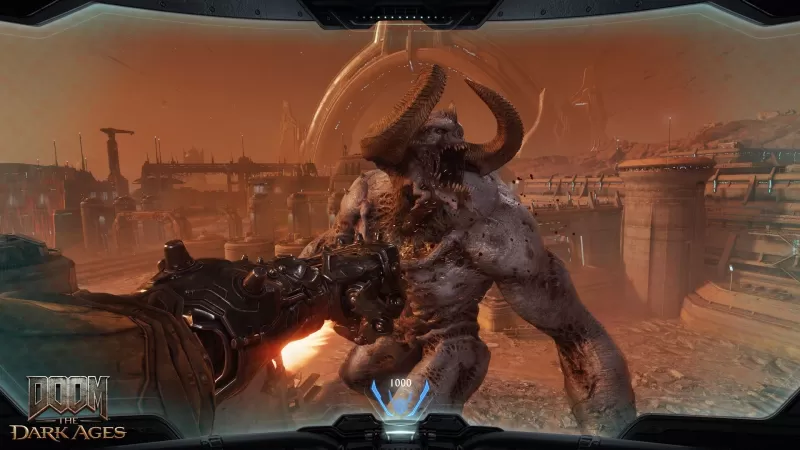Playing Doom: The Dark Ages brought back unexpected memories of Halo 3, especially during a thrilling segment where I mounted a cyborg dragon and unleashed a barrage of machinegun fire on a demonic battle barge. After taking out the vessel's defensive turrets, I landed my beast on the ship and stormed its lower decks, reducing the crew to a bloody pulp. Moments later, I burst through the hull, leaping back onto my dragon to continue my relentless assault on Hell's machines.
Fans of Bungie's iconic Xbox 360 title will recognize the resemblance to Master Chief's attack on the Covenant's scarab tanks. While the helicopter-like Hornet has been replaced by a holographic-winged dragon and the mech with an occult flying boat, the essence of the experience remains: a seamless transition from aerial assault to a devastating boarding action. Interestingly, this wasn't the only Halo-like moment in the demo. Despite The Dark Ages' combat core staying true to Doom's roots, the campaign's design evokes a late-2000s shooter vibe with its elaborate cutscenes and emphasis on gameplay novelty.

Over the course of two and a half hours, I played through four levels of Doom: The Dark Ages. The campaign's opener mirrored the tightly paced, meticulously designed levels of Doom (2016) and its sequel. However, subsequent levels introduced me to piloting a colossal mech, flying the dragon, and navigating a sprawling battlefield filled with secrets and formidable minibosses. This represents a significant shift from Doom's traditional focus on mechanical purity, drawing parallels with Halo, Call of Duty, and even classic James Bond games like Nightfire, which are known for their scripted setpieces and innovative mechanics.
This new direction for Doom is intriguing, especially considering the series once moved away from such elements. The cancelled Doom 4 was envisioned as a more Call of Duty-like experience, complete with a modern military aesthetic and a focus on cinematic storytelling and scripted events. id Software ultimately decided these weren't suitable for Doom, leading to the development of the more focused Doom (2016). Yet, here we are in 2025, with The Dark Ages reintroducing these elements.
The campaign's brisk pace is punctuated by novel gameplay elements that echo Call of Duty's most memorable moments. My demo began with a lengthy and detailed cutscene that reintroduced the realm of Argent D'Nur, the opulent Maykrs, and the Night Sentinels, portraying the Doom Slayer as a terrifying legend. This deeply cinematic approach feels fresh and reminiscent of Halo, with NPC Night Sentinels scattered throughout the environment, much like UNSC Marines. Although they don't fight alongside you in the levels I played, there's a stronger sense of being part of a larger force.
The introductory cutscene contains substantial character development, and it remains to be seen whether Doom truly needs this. Personally, I appreciate the minimalistic storytelling of the previous games, and I would prefer The Dark Ages to continue telling the Slayer's tale through environmental design and codex entries, using cinematics sparingly for major reveals, as seen in Eternal. However, these cutscenes are used effectively to set up missions without disrupting Doom's signature intensity.
Other interruptions come in the form of new gameplay mechanics. After the opening mission, which started with pure shotgun action and concluded with parrying Hell Knights using the Slayer's new shield, I found myself in the cockpit of a Pacific Rim-style Atlan mech, battling demonic kaiju. Then, I was soaring on the cybernetic dragon, attacking battle barges and gun emplacements. These scripted sequences create a significant shift in pace, introducing gameplay ideas similar to Call of Duty's novelties, like the AC-130 gunship sequence in Modern Warfare or the dogfighting missions in Infinite Warfare. The Atlan is slow and heavy, making Hell's armies appear like Warhammer miniatures, while the dragon is fast and agile, offering a vastly different experience from classic Doom.

Many of the best FPS campaigns thrive on such variety. Half-Life 2 and Titanfall 2 set the standard, and Halo's enduring appeal partly stems from its mix of vehicular and on-foot sequences. However, I'm uncertain if this approach suits Doom. Like Eternal, The Dark Ages remains a complex shooter that demands your full attention as you juggle shots, shield tosses, parries, and melee combos. In contrast, the mech and dragon sequences feel less engaging and more scripted, almost resembling QTEs.
In Call of Duty, switching to a tank or gunship feels natural because the mechanical complexity aligns well with on-foot missions. But in The Dark Ages, there's a noticeable disparity between gameplay styles, akin to a novice playing alongside a virtuoso. While Doom's core combat will always be the star, I shouldn't be longing for the ground combat with a double-barrelled shotgun when piloting a rocket-powered mech.
My final hour of gameplay introduced another shift, but this time built on a more solid foundation. The "Siege" level refocuses on id's exceptional gunplay while opening up the typically claustrophobic level design into a vast battlefield. The objective, to destroy five Gore Portals, mirrors Call of Duty's multi-objective missions but also evokes Halo's contrast between interior and exterior environments. This larger space forces you to rethink the effective range of your weapons, use your charge attack to cover vast distances, and deploy your shield to deflect artillery from tank cannons.
Expanding Doom's playspace can lead to a loss of focus, as I found myself backtracking and navigating empty pathways, which can disrupt the game's pace. To enhance this, I would have liked The Dark Ages to incorporate the dragon more like Halo's Banshee, allowing aerial traversal and divebombing into miniboss battles, which could maintain the pace and better integrate the dragon into the experience.
Despite the series' past rejection of such elements, it's fascinating to see The Dark Ages revisiting and reinterpreting ideas from the cancelled Doom 4, which was described as having many scripted setpieces and an obligatory vehicle scene. Talking to Noclip in 2016, id Software's Marty Stratton confirmed that Doom 4 was more cinematic and story-driven, resembling Call of Duty. Now, The Dark Ages brings back these elements, featuring large boarding action setpieces, lush cinematics, a broader cast of characters, and significant lore reveals.
The question remains: were these ideas always a bad fit for Doom, or did they just seem wrong when they mirrored Call of Duty too closely? While part of me remains skeptical, I'm also intrigued by id Software's attempt to integrate these elements into the modern Doom formula. The core of The Dark Ages is undoubtedly its intense, on-foot combat, which remains the campaign's highlight. However, id Software seems intent on experimenting further, and while some of these new ideas feel mechanically thin, there's still much to explore. I eagerly await May 15th to experience more of id's unparalleled gunplay and to see if Doom: The Dark Ages will be a compelling late-2000s FPS campaign or a disjointed one.
 Home
Home  Navigation
Navigation






 Latest Articles
Latest Articles










 Latest Games
Latest Games












